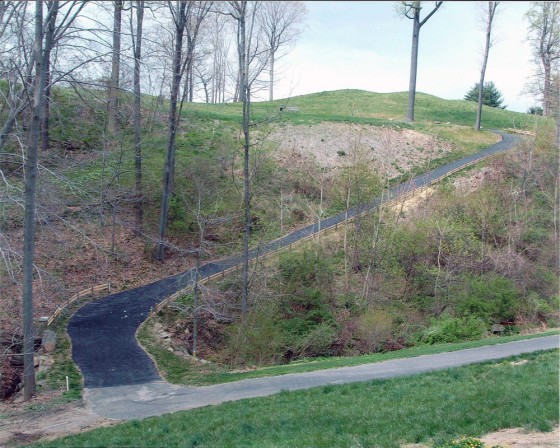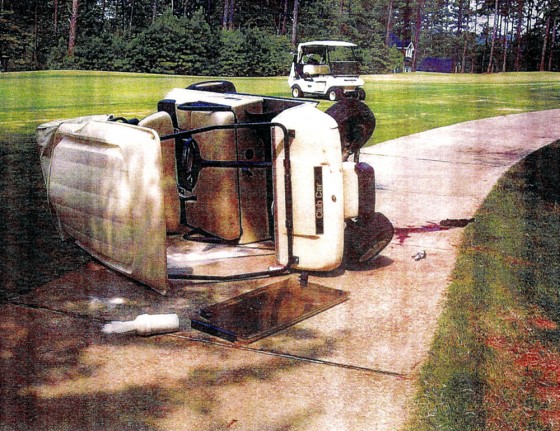According to the Consumer Products Safety Commission (CPSC), there are approximately 15,000 golf cart related injuries requiring emergency room treatment in the US each year. Some 10% of these accidents involve a rollover.
Golf carts are typically designed with brakes only on the rear axle. As our engineers have addressed in several peer-reviewed journal papers, this can result in the vehicle becoming unstable. A golf cart rollover often occurs as a result of a driver losing control of the car while traveling downhill on a car path. One potential source of a downhill loss of control is the current industry practice of manufacturing golf carts with brakes on only the rear axle wheels. It has long been understood that a braked vehicle with skidding rear tires and rolling front tires is directionally unstable but this instability will not always manifest itself when a vehicle is traveling at sufficiently low speeds on level ground. However, besides reducing braking effectiveness (when compared to four wheel braking), rear wheel only brake designs can easily lead to “fishtailing.” Furthermore, the reduced braking effectiveness on downhill slopes can lead the driver to falsely perceive a brake failure, causing him to press harder on the brake pedal, which in turn leads to a locking of the braked wheels and an out-of-control skid. This hazard is aggravated at golf courses that incorporate hilly terrain with steep, narrow golf cart paths and sharp turns. Such conditions make it desirable to create golf carts with good braking characteristics for use on courses with downhill slopes of 10 degrees or more.

Industry standards for the design of golf carts contain minimal braking requirements that do not include tests for downhill braking. In addition, there are no widely accepted standards for golf cart path design, and inadequate recommendations provided by car manufacturers for maximum path slope and minimum turning radii are ambiguous with warnings that refer to “steep grades” and “sharp turns” without quantifying these terms. This separation between golf cart design standards, which only require dynamic braking tests on flat ground, and sloped car path design, which lack any specificity, causes golf carts to be routinely driven on potentially dangerous terrain that is not addressed by the ANSI golf car standard. In addition, while the ANSI standard requires that a golf car’s maximum speed not exceed 15 mph on level ground, that speed can easily be exceeded when traveling downhill.
To evaluate the potential hazards of creating golf carts equipped with brakes on only the rear axle wheels, Technology Associates has analyzed the braking of a two-axle vehicle, equipped with brakes on either or both of its axle wheels. In addition, dynamic two-dimensional simulations of a braking golf cart traveling downhill have been created to study vehicle dynamic stability (and resulting rollover propensity). For this comparison, we introduce the term “braking efficiency”, defined as the actual vehicle braking deceleration, divided by the braking deceleration of the same vehicle with brakes on all four wheels (i.e. the maximum possible braking deceleration for a given slope and coefficient of friction). Thus, by definition, the case with braking on all four wheels yields an efficiency of 100%.

For either case where only the front or rear wheels are braked hard, braking efficiency decreases rapidly as the downhill slope increases, such that at path down slopes over 20 degrees, the brakes are no longer able to prevent the golf cart from accelerating downhill. For slopes of 10-15 degrees, with which golf carts must currently contend, placing brakes on only the rear axle wheels provides only 25-37% of the braking that could be achieved with brakes on all four wheels. Therefore, equipping a car with brakes on only the rear wheels reduces the available braking efficiency significantly when compared to a vehicle with brakes on all four wheels.
Dynamic simulations indicate that golf cart yaw instability (and subsequent rollover) is not likely on flat ground at speeds under 15 mph and therefore will not manifest itself during ANSI brake performance testing. However, for a vehicle with brakes on the rear wheels only, when the initial speed is 17 mph or higher, yaw instability can occur when traveling down a 10 degree slope when modest steering inputs are made. Such loss of control could easily cause the car to leave the path and either collide with, or tip over, nearby obstacles and path curbs.  However, when the front axle wheels, or all four wheels, are braked hard enough to lock them, there is no significant deviation from straight path travel. Therefore, if the cars were equipped with front brakes (either by themselves only, or in combination with rear brakes) this yaw instability problem would be significantly reduced if not entirely eliminated, and the risk of rollovers would be greatly reduced.
However, when the front axle wheels, or all four wheels, are braked hard enough to lock them, there is no significant deviation from straight path travel. Therefore, if the cars were equipped with front brakes (either by themselves only, or in combination with rear brakes) this yaw instability problem would be significantly reduced if not entirely eliminated, and the risk of rollovers would be greatly reduced.